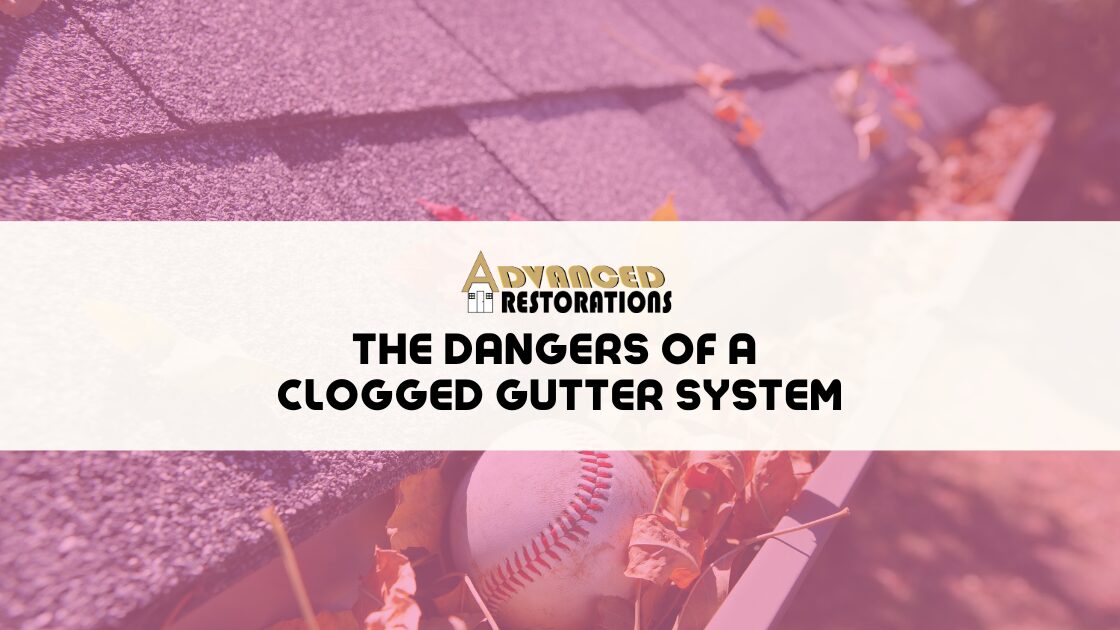
The Dangers of a Clogged Gutter System
We’ve previously discussed basic gutter cleaning and maintenance for the average homeowner. Like much of the exterior items on a home, it’s hard to consider potential issues until they’re causing larger problems, but an ounce of prevention now is truly worth its weight in gold.
Aluminum seamless gutter systems are installed on your property to help direct water (through rainfall or snowmelt) away from the direct exterior. As rain sheets down from the roofing system, it collects in the gutter system, travels to the various downspouts, and is then deposited to the ground some distance away.
Allowing rainfall to hit directly at the foundation of a home can quickly lead to erosion and eventually to foundation damage. Many homeowners could avoid expensive repairs to their foundation and framing had they installed a seamless gutter system.
But not you, our ever-present intelligent homeowner, you have a gutter system installed – you even have a scheduled maintenance plan for the gutters. You’re in the clear, right? Right? In most cases, that is correct – especially if you keep a plan of periodic cleanings. However, missing a planned cleaning or putting it off for the future can quickly cause problems to stack up.
A gutter system full of debris will have a harder time flowing water through it. Obviously, just like a stream, if a dam were to suddenly appear – the water would have nowhere to flow, and it would quickly backfill to become a lake or reservoir. The same situation can happen in your gutter system.
Through a build-up of debris (typically plant matter mixed with shingle granules), that waterflow can be blocked from going to its intended destination of the downspout. Eventually, that water will have enough volume that it has no choice but to flow over the top of the gutters – that creates a two-fold problem. One, we now have that direct waterfall impacting around the foundation of the home and two, that water can backflow to the roofing system itself.
On your average residential home your roofing system should be surrounded with metal drip edge, essentially the perimeter for the asphalt shingles. The drip edge overhangs the edge of the roof surface and beneath it is the fascia or forward-facing edge of the roof framing. This is often painted wood but is also likely to be colored aluminum metal as well. In our clogged gutter scenario, that backflow of water is constantly pushing back against both the drip edge and the fascia, leaving both items continuously satirized with water.
As you likely know, water tends to eventually find its way into the smallest cracks – any potential gaps in the fascia or drip edge will soon have moisture spreading through them. With simple wood fascia, the wood itself eventually becomes waterlogged and without an opportunity to dry, rot begins to set in.
The rot process is often a slow one and can be hard to identify until it has fully given way to allow water into the interior of the home. This may start with a discolored stain on a ceiling or potentially even traveling down a wall. Many homeowners overlook this issue and simply paint over the stain, thinking it’s merely a cosmetic issue to deal with.
That water saturation will continue to grow and spread, further creating issues with the interior but also traveling to the roof sheathing. Over time, standing outside the home you’ll eventually notice one area of the roofing system that seems to sag lower than other areas – that’s due to the rot spreading through the sheathing. If we are to this point, it’s very likely the damage to the interior of the home will be quite extensive, more and more ceiling stains will be noticed, and you may possibly see actual holes in sections of the drywall.
Something that started as small as a few too many leaves and partial sticks in a gutter system can eventually lead to thousands upon thousands of dollars in repairs. However, the solution to this problem is to head off the issue before it has a chance to begin.
Obviously, the maintenance and cleaning program is a great way to start but, if you’re worried about performing that work yourself or concerned with the recurring bill of hiring a service to complete it – there is another solution as well.
Solutions
Gutter guards, gutter helmets, gutter screens – while these terms do apply to very different items, they’re often used interchangeably to discuss the same process. Installing a shield that resides on top of the existing gutter system.
Gutter Guards – The most common product you’ll see on most homes. They are typically metal but may be vinyl, the small holes allow water to pass through but keeps larger debris out of the main gutter system. Guards may be friction fit – essentially pressed into the top of the gutter system, some call to be laid on top of the gutter system and installed with screws, and some products will be large enough to sit just under the lowest rows of shingles and extend out to the edge of the gutter system.
Gutter Screens – As the name implies, these are essentially window screens for your gutter system. This is typically the cheapest option of the bunch but that is normally due to the overall lower quality of the materials as well as durability. Screens will work for a time if installed properly but you’re usually on a countdown until the product takes on damage and the screens rip, allowing debris back into the gutter system.
Gutter Helmet – Helmets are the more expensive option of the three items, installation is often a more involved process but many helmet systems offer various levels of warranty. Typically, helmets are attached directly to the gutter system and involve a solid metal surface with vented areas that allow water to pass through – as they are more solid in nature, helmet systems tend to be quite durable.
Which system makes the most sense for you as a homeowner? That will depend on several factors, including the financial investment you’d like to make in your property. Gutter Helmets can have an aesthetic value that is not always provided by the other options. Gutter guards are the utility-infielder of this type of product, they’re available at a reasonable cost and they perform their job as expected. Gutter screens, while the most affordable option, are likely to have a limited timeframe of viability.
When pressed for our opinion, Advanced Restorations will rely on gutter guards as the best option for most homeowners. They’re a cost-effective option that performs at a level very close to most gutter helmet systems. As an added benefit, maintenance can be performed at the homeowner level in emergency situations – the same cannot be said for gutter helmets.
Despite which product appeals to you, Advanced Restorations is a contractor that will be able to offer service for all three options. Call our office today at (417) 229-0667 to schedule an appointment with one of our capable Field Supervisors to further discuss your gutter needs!
